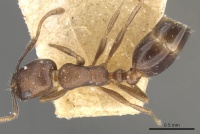Monomorium schurri
| Monomorium schurri | |
|---|---|

| |
| Scientific classification | |
| Kingdom: | Animalia |
| Phylum: | Arthropoda |
| Class: | Insecta |
| Order: | Hymenoptera |
| Family: | Formicidae |
| Subfamily: | Myrmicinae |
| Tribe: | Solenopsidini |
| Genus: | Monomorium |
| Species: | M. schurri |
| Binomial name | |
| Monomorium schurri Forel, 1902 | |
Identification
Distribution
Distribution based on Regional Taxon Lists
Oriental Region: India (type locality), Pakistan.
Distribution based on AntMaps
Distribution based on AntWeb specimens
Check data from AntWeb
Countries Occupied
| Number of countries occupied by this species based on AntWiki Regional Taxon Lists. In general, fewer countries occupied indicates a narrower range, while more countries indicates a more widespread species. |

|
Estimated Abundance
| Relative abundance based on number of AntMaps records per species (this species within the purple bar). Fewer records (to the left) indicates a less abundant/encountered species while more records (to the right) indicates more abundant/encountered species. |

|
Biology
This species is found in grasslands, field crops of maize and wheat, apple orchards and pine trees. (Mohyuddin et al., 2020)
Castes
Nomenclature
The following information is derived from Barry Bolton's Online Catalogue of the Ants of the World.
- schurri. Monomorium schurri Forel, 1902c: 212 (w.q.) INDIA (no state data).
- Type-material: syntype worker(s), syntype queen(s) (numbers not stated).
- Type-locality: India: (no further data).
- [Note: Forel, 1903a: 688, records “Pachmari (Schurr)”, which is probably the type-locality.]
- Type-depository: MHNG.
- Combination in M. (Xeromyrmex): Emery, 1922e: 178.
- Status as species: Forel, 1903a: 688; Bingham, 1903: 203; Emery, 1922e: 178; Chapman & Capco, 1951: 166; Ettershank, 1966: 92; Bolton, 1995b: 266; Tiwari, 1999: 57; Mathew & Tiwari, 2000: 305; Bharti, Guénard, et al. 2016: 40; Rasheed, et al. 2019: 433.
- Distribution: India, Myanmar, Pakistan.
Description
Worker
Bingham (1903): Dark chestnut-brown, almost dark brown, the flagellum of the antennae (especially at base), the 2nd node of the pedicel, and the articulations of the abdominal segments a sort of dull pale yellow; head, thorax and node of pedicel very finely rugulose, having a dull opaque appearance, abdomen smooth and shining; in certain lights the head is seen to be minutely longitudinally striate, the pronotum just as minutely but transversely striate: pilosity very sparse, only a few erect hairs on the front oF the head and apex of the abdomen; pubescence somewhat dense, but very short and inconspicuous on the scape of the antennae and tibiae of the legs. Head longer than broad; mandibles shining, narrow, the masticatory margin armed with 4 teeth; clypeus convex in the middle, slightly shining, the carinae obtuse; antennae short, the scape not extending to the top of the head; eyes a little below the middle of the sides of the head. Thorax anteriorly broad, narrowing posteriorly, the anterior margin of the pronotum arched, the anterior lateral angles of the thorax a little pronounced; meso-metanotal suture slight; basal face of metanotum long, narrow, compressed, convex, passing into the apical portion by a rounded curve, and bearing an impression giving the posterior lateral angles of the metanotum an appearance of being subtuberculate. Pedicel: 1st node conical, anteriorly shortly petiolate: 2nd node broader than long and above much broader than the 1st; abdomen elongate, oval.
Length: 2.2 - 2.5 mm
Queen
Bingham (1903): "Ergatoid. Three small ocelli. Mesonotum a little dilated but without articulations for the wings. Metanotum bidentate. First node of the pedicel squamiform. Abdomen with the appearance of a queen. The rest as in the worker."' (Forel.)
Length: 3.7 mm
References
- Emery, C. 1922c. Hymenoptera. Fam. Formicidae. Subfam. Myrmicinae. [part]. Genera Insectorum 174B: 95-206 (page 178, Combination in M. (Xeromyrmex))
- Forel, A. 1902c. Myrmicinae nouveaux de l'Inde et de Ceylan. Rev. Suisse Zool. 10: 165-249 (page 212, worker, queen described)
- Khudadad, S., Rafi, M.A., Zia, A., Khan, M.S., Parveen, G., Sheikh, M.K., Naz, F., Qasim, M., Shah, S.W. 2021. Ant fauna (Hymenoptera: Formicidae) of District Mansehra, Pakistan. Pakistan Journal of Agricultural Research 34: 664-671 (doi:10.17582/journal.pjar/2021/34.3.664.671).
- Mohyuddin, G., Bashir, A., Mahmood, A., Sharif, T., Waheed, I., Ahmed, S. 2020. Taxonomic studies of family (Formicidae: Hymenoptera) six genera from district Faisalabad Punjab Pakistan. Journal of Entomology and Zoology Studies 8(1): 1384-1389.
- Rasheed, M.T., Bodlah, I., Fareen, A.G., Wachkoo, A.A., Huang, X., Akbar, S.A. 2019. A checklist of ants (Hymenoptera: Formicidae) in Pakistan. Sociobiology 66(3), 426-439 (doi:10.13102/sociobiology.v66i3.4330).
References based on Global Ant Biodiversity Informatics
- Ettershank G. 1966. A generic revision of the world Myrmicinae related to Solenopsis and Pheidologeton (Hymenoptera: Formicidae). Aust. J. Zool. 14: 73-171.
- Forel A. 1903. Les Formicides de l'Empire des Indes et de Ceylan. Part X. J. Bombay Nat. Hist. Soc. 14: 679-715.
- Mathew R., and R. N. Tiwari. 2000. Insecta: Hymenoptera: Formicidae. Pp. 251-409 in: Director; Zoological Survey of India (ed.) 2000. Fauna of of Meghalaya. Part 7. [State Fauna Series 4.] Insecta 2000. Calcutta: Zoological Survey of India, 621 pp.
- Rasheed M. T., I. Bodlah, A. G. Fareen, A. A. Wachkoo, X. Huang, and S. A. Akbar. 2019. A checklist of ants (Hymenoptera: Formicidae) in Pakistan. Sociobiology 66(3): 426-439.
- Umair M., A. Zia, M. Naeem, and M. T. Chaudhry. 2012. Species composition of ants (Hymenoptera: Formicidae) in Potohar Plateau of Punjab Province, Pakistan. Pakistan Journal of Zoology 44(3): 669-705.

